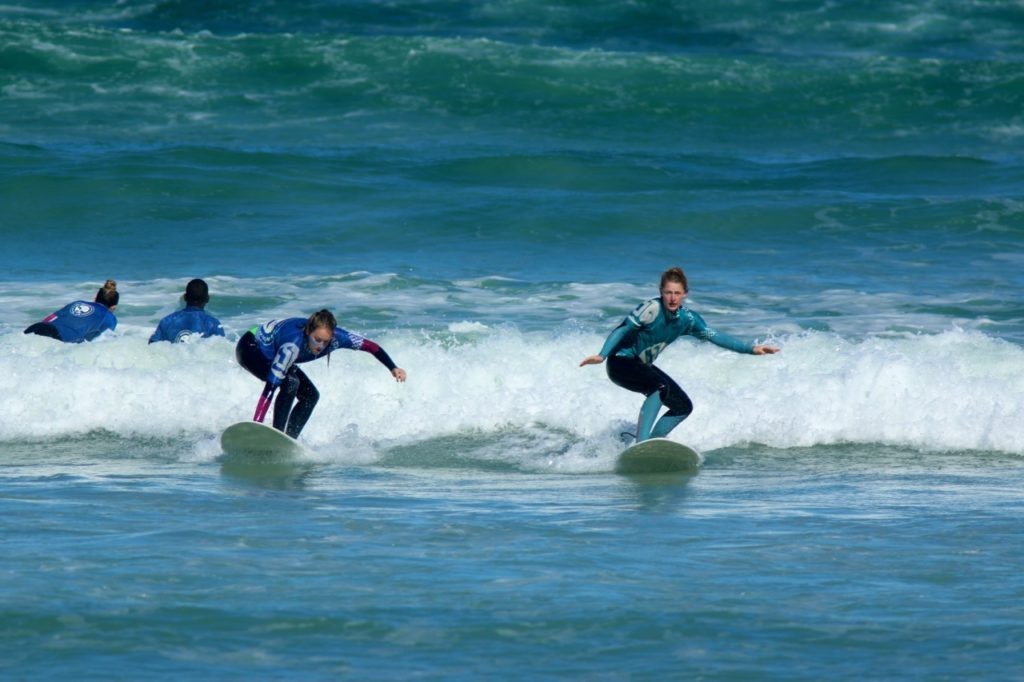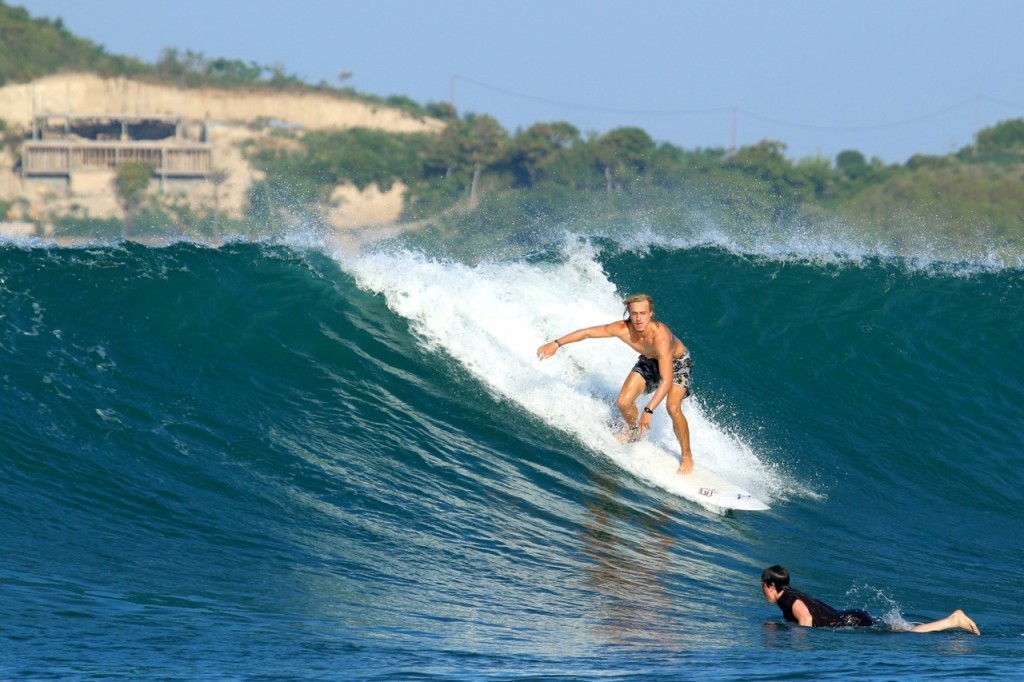How Long It Takes To Learn Surfing is a common question, and LEARNS.EDU.VN is here to provide you with a comprehensive answer, exploring the factors influencing your surfing journey and offering a realistic timeline for skill development. Discover valuable insights, expert tips, and educational resources to help you progress from a beginner to a confident surfer, and master paddling techniques, wave selection skills and ocean awareness.
1. Understanding the Allure of Surfing
Surfing captivates people worldwide with its blend of athleticism, nature, and personal challenge. More than just a sport, it’s a lifestyle that fosters a deep connection with the ocean and a sense of freedom. However, many aspiring surfers wonder, “How long will it realistically take for me to learn to surf?” This question doesn’t have a simple answer, as the journey of learning to surf is influenced by various elements.
1.1. Defining “Learning to Surf”
Before diving into timelines, it’s crucial to define what “learning to surf” means to you. Are you aiming to simply stand up on a board, or do you aspire to perform advanced maneuvers?
- Beginner: Able to stand up on small, gentle waves consistently.
- Intermediate: Confidently riding unbroken waves, performing basic turns, and understanding wave selection.
- Advanced: Executing complex maneuvers like snaps, cutbacks, and potentially aerials, with a deep understanding of wave dynamics.
1.2. Setting Realistic Expectations
It’s tempting to dream of becoming a surf pro overnight, but it’s crucial to set realistic expectations. Surfing requires patience, persistence, and a willingness to learn from both successes and wipeouts. Remember that progress isn’t always linear, and there will be days when you feel like you’re not improving. Embrace the journey, and celebrate small victories along the way.
2. Factors Influencing Your Surfing Learning Curve
Several factors play a significant role in how quickly you learn to surf. Understanding these factors can help you tailor your approach and optimize your learning experience.
2.1. Physical Fitness
Surfing demands a reasonable level of physical fitness. Strong paddling power, core stability, and overall endurance are essential for catching waves and maintaining balance on the board.
Table: Physical Fitness Components for Surfing
| Component | Description | Benefits |
|---|---|---|
| Paddling Strength | The ability to efficiently propel yourself through the water using your arms and shoulders. | Catching waves more easily, positioning yourself effectively, and avoiding fatigue. |
| Core Strength | Stability in your torso, which allows you to maintain balance and control on the board. | Improved balance, better control during turns, and reduced risk of injury. |
| Endurance | The ability to sustain physical activity over extended periods. | Longer surf sessions, more opportunities to practice, and increased wave count. |
| Flexibility | Range of motion in your joints, allowing for fluid movements and reducing the risk of muscle strains. | Easier pop-ups, smoother turns, and improved overall performance. |
| Cardiovascular | Efficient delivery of oxygen to your muscles, supporting sustained energy levels. | Increased stamina, faster recovery between waves, and improved overall surfing experience. |


2.2. Frequency and Consistency
Like any skill, surfing requires consistent practice. The more time you spend in the water, the faster you’ll progress. Aim for regular surf sessions, even if they’re just for an hour or two. Consistency trumps sporadic long sessions.
2.3. Quality of Instruction
Learning from a qualified surf instructor can significantly accelerate your progress. A good instructor will provide personalized guidance, teach you proper techniques, and ensure your safety in the water. Look for instructors certified by reputable organizations.
2.4. Wave Conditions
The type of waves you learn on greatly impacts your learning curve. Beginners should start with small, gentle waves on a sandy beach. As you progress, you can gradually move on to larger and more challenging waves.
2.5. Equipment
Using the right equipment can make a world of difference. Beginners should opt for a long, wide surfboard that provides stability and makes it easier to paddle and stand up. As you improve, you can transition to shorter, more maneuverable boards.
2.6. Location
Some surf spots are more conducive to learning than others. Look for beaches with consistent, gentle waves and a supportive surf community. Avoid crowded spots or areas with strong currents or hazardous conditions.
2.7. Natural Ability and Coordination
While surfing is a skill that can be learned, some individuals may have a natural aptitude for it. Factors like balance, coordination, and spatial awareness can influence your learning speed.
2.8. Fear and Confidence
Overcoming fear and building confidence are crucial aspects of learning to surf. It’s natural to feel apprehensive when paddling out into the ocean, but learning to manage your fear and trust your abilities will accelerate your progress.
3. Realistic Timelines for Learning to Surf
With all the factors in mind, let’s explore some realistic timelines for achieving different levels of surfing proficiency.
3.1. The First Day: Standing Up
For most beginners, the primary goal of the first surf lesson is to stand up on the board. With proper instruction and favorable conditions, many people can achieve this milestone within the first few hours. However, standing up once doesn’t mean you’ve learned to surf. It’s just the first step in a long and rewarding journey.
3.2. 1-3 Months: Beginner Basics
Within 1-3 months of consistent surfing (2-3 times per week), you can expect to:
- Consistently stand up on small, gentle waves.
- Paddle efficiently and position yourself effectively.
- Understand basic surf etiquette and safety rules.
- Catch waves independently.
3.3. 6-12 Months: Intermediate Skills
After 6-12 months of regular surfing, you can aim to:
- Confidently ride unbroken waves.
- Perform basic turns (frontside and backside).
- Understand wave selection and positioning.
- Surf in a variety of conditions.
3.4. 2+ Years: Advanced Surfing
Reaching an advanced level of surfing typically takes 2 or more years of dedicated practice. At this stage, you can expect to:
- Execute advanced maneuvers like snaps, cutbacks, and potentially aerials.
- Read and understand complex wave dynamics.
- Surf confidently in a variety of wave sizes and conditions.
- Have a deep understanding of surf culture and etiquette.
4. Maximizing Your Learning Potential
Here are some practical tips to help you accelerate your surfing journey:
4.1. Set Specific Goals
Instead of just aiming to “get good,” set specific, measurable, achievable, relevant, and time-bound (SMART) goals. For example, “I want to be able to confidently perform a frontside turn on a 3-foot wave within 3 months.”
4.2. Cross-Training
Supplement your surfing with exercises that improve your paddling strength, core stability, and overall fitness. Swimming, yoga, and strength training are excellent options.
4.3. Surf with More Experienced Surfers
Observe and learn from more experienced surfers. Watch how they paddle, position themselves, and ride waves. Don’t be afraid to ask them for tips and advice.
4.4. Video Analysis
Record your surf sessions and analyze your technique. Identify areas for improvement and focus on correcting them in your next session.
4.5. Visualize Success
Before you paddle out, visualize yourself successfully catching waves and performing maneuvers. Mental rehearsal can boost your confidence and improve your performance.
4.6. Be Patient and Persistent
Learning to surf takes time and effort. Don’t get discouraged by setbacks. Celebrate small victories and keep practicing. The more time you spend in the water, the better you’ll become.
5. Common Mistakes to Avoid
To accelerate your learning and avoid frustration, be aware of these common mistakes:
5.1. Using the Wrong Equipment
Starting with a board that’s too small or difficult to paddle can hinder your progress. Choose a board that’s appropriate for your skill level and the wave conditions.
5.2. Poor Paddling Technique
Inefficient paddling wastes energy and makes it harder to catch waves. Learn the correct paddling technique, using your entire body to generate power.
5.3. Looking Down
Looking down at your feet throws off your balance and prevents you from seeing the wave ahead. Keep your eyes focused on the horizon.
5.4. Incorrect Stance
Adopting the wrong stance can make it difficult to maintain balance and control. Practice your pop-up on land to develop muscle memory.
5.5. Ignoring Surf Etiquette
Dropping in on other surfers or paddling in front of them is dangerous and disrespectful. Learn and follow the rules of surf etiquette.
5.6. Surfing in Conditions Beyond Your Ability
Pushing yourself too hard can lead to injury or a negative experience. Surf in conditions that are appropriate for your skill level.
6. Surfing as a Lifelong Journey
Learning to surf is not just about mastering techniques; it’s about embracing a lifestyle. It’s about connecting with nature, challenging yourself, and finding joy in the simple act of riding a wave. Even after years of surfing, there’s always something new to learn and explore.
6.1. Continuous Learning
The ocean is constantly changing, and so is surfing. Stay curious, experiment with new techniques, and never stop learning.
6.2. Community
Surfing is a social activity. Connect with other surfers, share your experiences, and learn from each other.
6.3. Respect for the Ocean
Surfing is a privilege. Respect the ocean, its creatures, and the environment. Practice responsible surfing habits.
7. The Role of Technology in Learning to Surf
Modern technology offers various tools and resources to enhance your surfing education.
7.1. Surf Forecast Websites and Apps
Websites like Surfline and Magicseaweed provide detailed information about wave height, swell direction, wind conditions, and tide charts. Understanding these factors can help you plan your surf sessions and choose the best spots.
7.2. Wearable Technology
Smartwatches and surf-specific trackers can record data about your surf sessions, such as wave count, distance paddled, and speed. Analyzing this data can help you identify areas for improvement.
7.3. Online Surf Tutorials
YouTube and other online platforms offer a wealth of surf tutorials, covering everything from basic techniques to advanced maneuvers. Watch videos from reputable instructors to learn new skills and refine your technique.
7.4. Virtual Reality (VR) Surfing
VR surfing simulators allow you to experience the sensation of riding a wave in a safe and controlled environment. While not a substitute for actual surfing, VR can be a valuable tool for practicing your pop-up and developing muscle memory.
Table: Technological Tools for Surfing Education
| Tool | Description | Benefits |
|---|---|---|
| Surf Forecast Websites | Provide detailed information about wave conditions, swell direction, wind, and tides. | Planning surf sessions, choosing the best spots, and understanding wave dynamics. |
| Wearable Surf Trackers | Record data about wave count, distance paddled, speed, and other performance metrics. | Analyzing performance, identifying areas for improvement, and tracking progress. |
| Online Surf Tutorials | Offer instructional videos covering a wide range of surfing techniques and skills. | Learning new techniques, refining existing skills, and gaining insights from experienced surfers. |
| VR Surfing Simulators | Provide a virtual surfing experience, allowing users to practice pop-ups and other maneuvers in a controlled environment. | Developing muscle memory, practicing technique, and gaining confidence before hitting the water. |
8. Surfing Safety: A Paramount Consideration
Before embarking on your surfing journey, it’s essential to prioritize safety. Surfing, while exhilarating, can be dangerous if proper precautions aren’t taken.
8.1. Learn to Swim
Being a proficient swimmer is non-negotiable. You should be comfortable swimming in the ocean and able to handle currents and waves.
8.2. Surf with a Buddy
Always surf with a friend or in an area where other surfers are present. Having someone to watch out for you can be life-saving in case of an emergency.
8.3. Know Your Limits
Don’t surf in conditions that are beyond your ability. Start with small waves and gradually progress to larger ones as your skills improve.
8.4. Be Aware of Your Surroundings
Pay attention to the weather conditions, tides, currents, and potential hazards like rocks, reefs, or marine life.
8.5. Use a Leash
Always wear a leash to keep your board attached to your ankle. A runaway board can be dangerous to yourself and others.
8.6. Protect Yourself from the Sun
Wear sunscreen, a hat, and sunglasses to protect yourself from the sun’s harmful rays.
8.7. Stay Hydrated
Drink plenty of water before, during, and after your surf sessions to prevent dehydration.
8.8. Learn CPR and First Aid
Knowing CPR and basic first aid can be invaluable in case of an emergency.
9. Surfing and Mental Well-being
Beyond the physical benefits, surfing offers significant mental and emotional rewards.
9.1. Stress Reduction
The rhythmic motion of paddling, the focus required to ride a wave, and the connection with nature can all help reduce stress and anxiety.
9.2. Improved Mood
Surfing releases endorphins, which have mood-boosting effects. The feeling of accomplishment after riding a wave can also enhance your sense of well-being.
9.3. Increased Self-Confidence
Overcoming challenges in the ocean can build self-confidence and resilience.
9.4. Mindfulness
Surfing requires you to be present in the moment, fully focused on the wave and your surroundings. This can promote mindfulness and reduce mental clutter.
9.5. Connection with Nature
Surfing allows you to connect with the ocean and appreciate its beauty and power. This can foster a sense of awe and wonder.
10. Inspiring Stories of Surfing Success
Countless individuals have transformed their lives through surfing, overcoming challenges and achieving remarkable feats.
10.1. Bethany Hamilton
Despite losing her arm in a shark attack at the age of 13, Bethany Hamilton persevered and became a professional surfer, inspiring millions with her courage and determination.
10.2. Kelly Slater
Considered one of the greatest surfers of all time, Kelly Slater has won 11 World Surf League Championships, demonstrating the power of dedication and skill.
10.3. Duke Kahanamoku
Known as the “Father of Modern Surfing,” Duke Kahanamoku popularized surfing around the world and used his platform to promote peace and understanding.
These stories demonstrate that surfing is not just a sport; it’s a path to personal growth, resilience, and inspiration.
FAQ: Your Surfing Questions Answered
-
Is it hard to learn surfing?
Surfing can be challenging, but with proper instruction, consistent practice, and a positive attitude, anyone can learn to surf.
-
What is the best age to learn surfing?
There’s no age limit to learning surfing. People of all ages can enjoy the sport.
-
What equipment do I need to start surfing?
You’ll need a surfboard, leash, and appropriate swimwear.
-
How much do surf lessons cost?
The cost of surf lessons varies depending on the location and instructor, but typically ranges from $50 to $100 per hour.
-
What are the best surf spots for beginners?
Some popular surf spots for beginners include Waikiki Beach (Hawaii), Muizenberg (South Africa), and Kuta Beach (Bali).
-
How can I improve my paddling technique?
Focus on using your entire body to generate power, maintain a streamlined body position, and practice regularly.
-
How do I choose the right surfboard?
Consider your skill level, weight, and the type of waves you’ll be surfing. Beginners should opt for a long, wide board.
-
What is surf etiquette?
Surf etiquette includes rules like not dropping in on other surfers, paddling wide to avoid interfering with others, and respecting the locals.
-
How can I stay safe while surfing?
Learn to swim, surf with a buddy, know your limits, be aware of your surroundings, and use a leash.
-
What are the benefits of surfing?
Surfing offers physical benefits like improved fitness and coordination, as well as mental benefits like stress reduction and increased self-confidence.
Learning to surf is a journey, not a destination. Embrace the challenges, celebrate the victories, and enjoy the ride. Remember, LEARNS.EDU.VN offers a wealth of educational resources and expert guidance to help you on your surfing adventure.
Ready to catch your first wave or refine your surfing skills? Visit LEARNS.EDU.VN today to explore our comprehensive guides, connect with experienced instructors, and discover a world of surfing knowledge. Don’t wait, your surfing adventure awaits! Contact us at 123 Education Way, Learnville, CA 90210, United States, Whatsapp: +1 555-555-1212. Website: learns.edu.vn.
